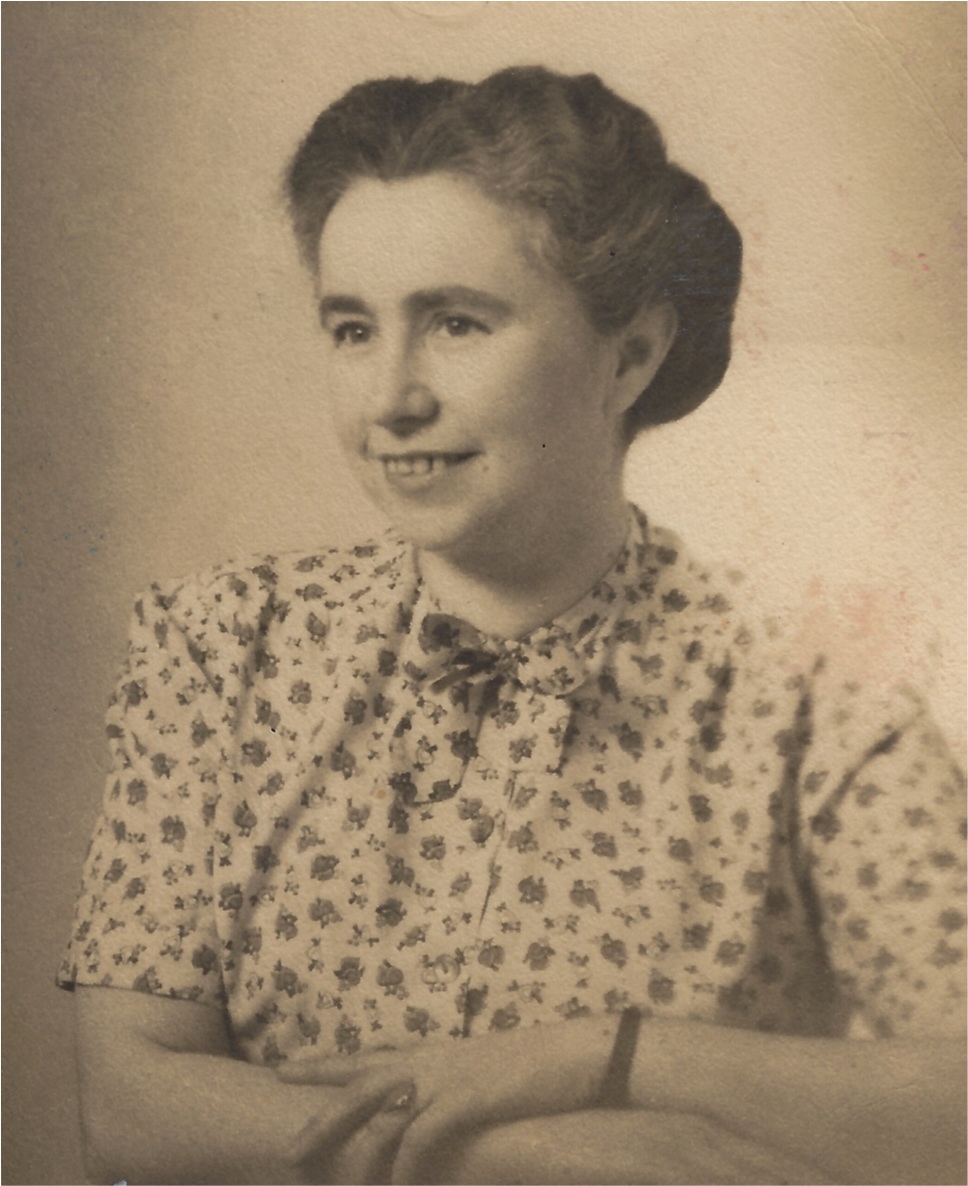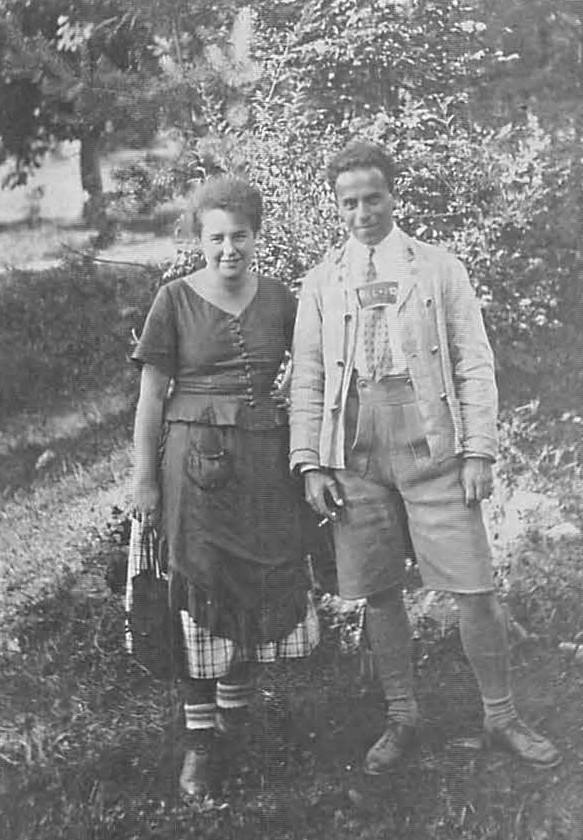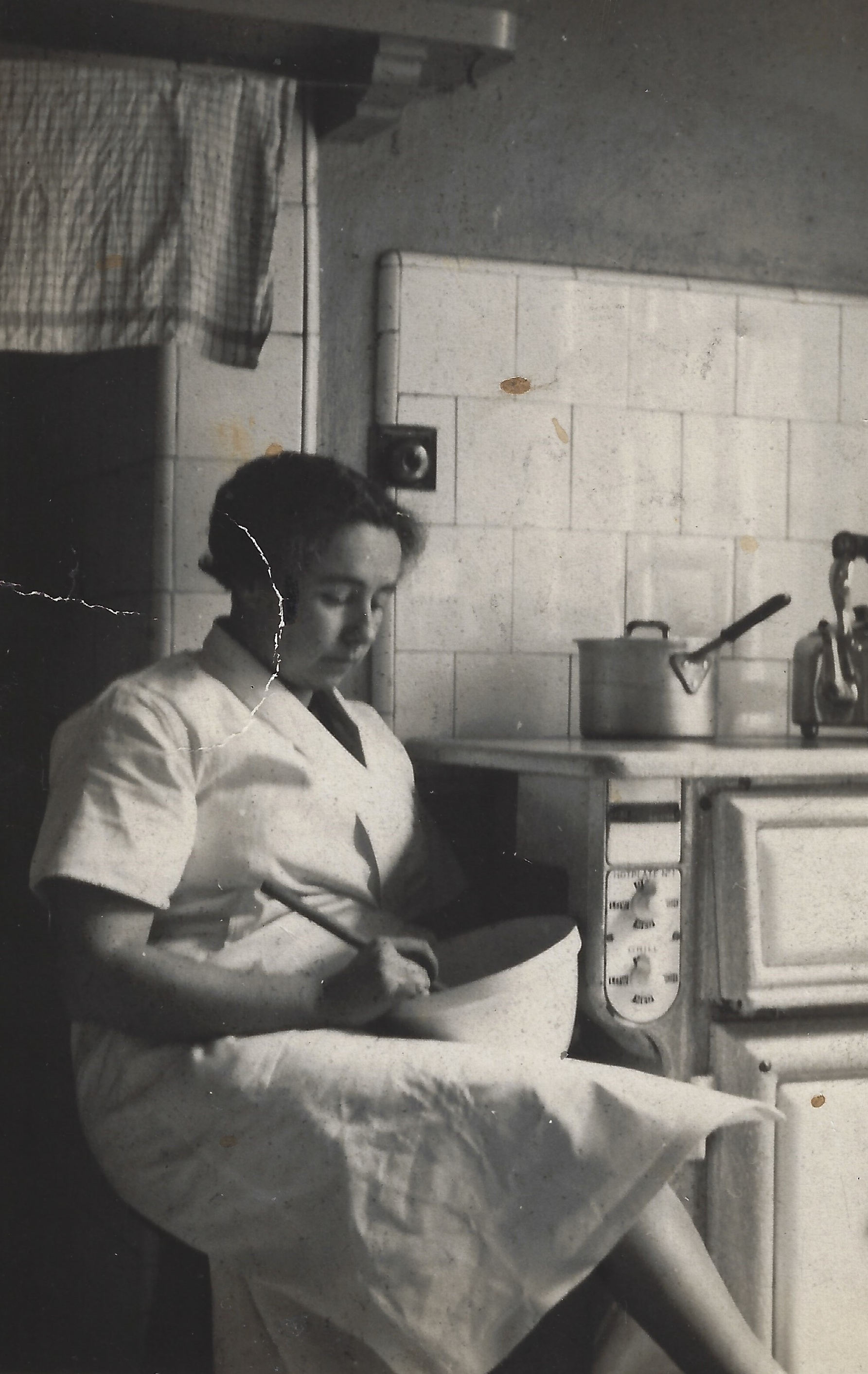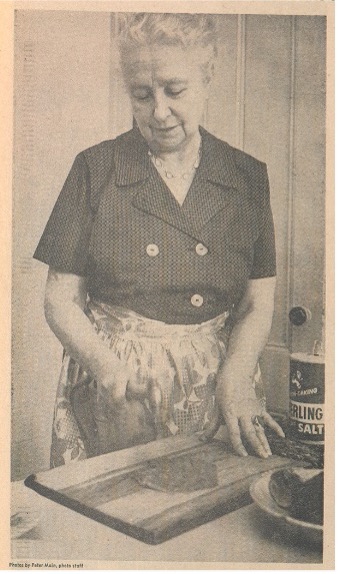Born on July 17, 1902, in Komárom, Austro-Hungarian Empire (today Komárno, Slovakia)
Died on January 31, 1995, in Wilmington, Delaware, United States
Occupation: Author, baker, bookstore clerk, and sales representative
Migration: Czechoslovakia, 1938 | Great Britain, 1938 | United States, 1940
“My memories from early childhood are very vivid. I remember not only the people, but also the environment. I can even visualize myself standing on a small step stool to reach the kitchen table. Whenever I could, I was in the kitchen ‘helping’; watching my mother […] This is the way I learned to cook when I was a little girl.” “An Authentic Strudel Instructor,” in: The Christian Science Monitor, 30 November 1972, 17. For Risa Pisko, the kitchen was a place of comfort, a site where she discovered the joys of cooking and baking. It was also a space where she learned skills that later served her and her family well after they emigrated from Nazi Vienna. Decades later, Pisko proved the value of these recipes as a preserver of memories by publishing those that reflected her Austro-Hungarian heritage.

Fig. 1: Risa Pisko in England, 1940; private collection © Eric Corty.
Risa Fried was born on 17 July 1902 in Komárom (Komárno), a town in the Austro-Hungarian Empire. She was the third child of Max (1867–1944) and Franziska Fried née Friedmann (1875–1940), with two older brothers, Fritz (1898–1968) and Ernö (1900–1943), and a younger sister, Hermine (1907–1994). Max Fried owned a coal and lumber business, and he built the family a large home where Pisko and her siblings had a care-free childhood.
Pisko’s father was an observant Jew who frequently went to services in the temple across the street from their home. As often as he attended services, his wife avoided them. Pisko, too, later eschewed religion, although this was less likely due to her mother’s influence and more likely because of persecution by Nazi officials.
From a young age, Pisko found herself frequently wandering into the kitchen. She not only watched the servants prepare the family meals, but she quickly began to contribute to the cooking and baking. Pisko’s knowledge of the kitchen proved to be a vital asset many times in her life, likely starting during the First World War when helping her mother and the servants provide fine meals to Hungarian officers billeted in their home.
Her skills were equally useful less than a decade later in the home of her in-laws. She met her future husband, an Austrian Jew named Ernst (later Ernest) Pisko (1896–1966), through her brother Fritz. They were married in a civil ceremony in Vienna on 16 August 1922, and soon thereafter, they moved into the Pisko family home in Vienna. Their only child, Susanne, was born on 19 April 1925. As with her circumstances growing up, Pisko lived a comfortable middle-class life as a wife and mother. However, she did contribute to running the bookstore that Ernest Pisko co-owned, and she worked for a company that published a fashion journal.

Fig. 2: Risa Pisko with her husband, Ernest Pisko, 1923. Both wear traditional Austrian clothing; private collection © Eric Corty.
This stable life abruptly ended in March 1938 when the German military marched into Austria, and, to the elation of many Austrians, but to the dismay of most Austrian Jews, Nazi Germany annexed Austria. Less than two weeks later, Pisko’s husband was arrested because he was a newspaper editor. As a condition of his release, he had to leave Austria. Ernest, Risa, and Susanne Pisko relocated to Komárom, which was part of Czechoslovakia until Hungary seized it in fall 1938. This land grab was the catalyst for the family to immigrate to Great Britain.
They arrived in December 1938, and like many Jews who had fled Austria and Germany, they had no knowledge of English. But Risa and Ernest Pisko did have jobs, respectively as a cook and a butler. Securing a domestic service job was the primary way that many people, especially young, unmarried women, were able to immigrate to England. Over 20,000 refugees, mainly women, escaped via this scheme. For Pisko, this service meant that once again, the kitchen had an important part in her life. She used an old cookbook to prepare meals for her employers and to learn English. She did not have much time to perfect her English cooking skills.

Fig. 3: Risa Pisko in the kitchen of her employer in England, 1940; private collection © Eric Corty.
In March 1940, the trio immigrated to the United States. While her husband returned to a career in journalism, Pisko found employment as a live-in cook. She returned to her Central European culinary roots to the great delight of this employer. As of 1942, she was no longer live-in help, but resided with her husband and daughter in an apartment in Brookline, Massachusetts. Still, cooking remained a source of income as Pisko worked in restaurants and a coffee shop. A couple of years later, she retired from culinary work and found employment as a bookstore clerk, drawing on her experiences in Vienna. She subsequently took on other roles in the book publishing business.
As with many Jews who escaped the Nazi regime, Pisko and her family were not unscathed by the Second World War. While her brother Fritz and her sister Hermine survived, her mother died in 1940, her other brother Ernö perished in a Soviet prisoner-of-war camp in 1943, and her father was murdered at Auschwitz in 1944. This tragedy did not dissuade Pisko and her husband from visiting Europe multiple times in the ensuing two decades, this time traveling as American citizens (Pisko had obtained citizenship in September 1945, her husband the month before). Most of this travel was for Ernest Pisko’s work for The Christian Science Monitor, a Boston-based newspaper that employed him as a writer and area specialist of Central Europe from 1940 until shortly before his death in October 1966. The Monitor is a secular newspaper published by the Christian Science Church, a religious movement founded in the late nineteenth century by the spiritual leader and author Mary Baker Eddy (1821–1910).
The loss of her husband was a terrible blow, but Pisko continued to lead a good life. This life included a renewed focus on recipes. In February 1966, she published five recipes in The Christian Science Monitor. From this first menu through her last dishes twenty-five years later, Pisko provided Monitor readers with an array of dinners, desserts, and sides that reflected her Central European heritage. In contrast, Pisko’s Jewish heritage is noticeably absent. Not one article accompanying any recipe hints at her Jewish background, and her periodic inclusion of bacon and bacon fat in ingredient lists as well as recipes for Christmas cakes and cookies suggests otherwise.

Fig. 4: Risa Pisko demonstrating how to make Wiener Schnitzel, 1966. Photo by Peter Main © The Christian Science Monitor (February 24, 1966. www.csmonitor.com)
Every article is infused with passion as well as Pisko’s excitement when discovering new recipes. As she wrote in one article, “When vacationing in Hungary or Austria I cannot resist watching the food served in my friends’ homes or in restaurants, hoping to find a dish I have not known yet.” Several other articles highlighted trips to Central Europe, and while a focus on finding new recipes may have been unique to Pisko’s travels, she was certainly not alone among former Austrian Jews who visited their past homelands in the years after 1945. Her recipes were never front-page news, but they were a recurring feature of The Christian Science Monitor for a quarter of a century. Over the course of some 150 recipes, she shared traditional Central European culinary experiences with Monitor readers.
In many ways, Pisko’s articles joined a Boston tradition of cooking, teaching, and publishing as a way for women to earn a livelihood and practice agency that dated back to the Boston Cooking School of the 1880s and its most famous pupil-turned-principal, the culinary expert Fannie Farmer (1857–1915). Boston’s cooking schools and its domestic scientists strove to set New England cuisine as a way to ease the assimilation of immigrants into New England culture. However, it was a culture that newcomers contributed to, as each group of immigrants brought its own culinary practices.
By the mid-1960s, when Pisko’s articles first appeared in the “Home and Family” section of The Christian Science Monitor, the diet of New Englanders had shifted to include a broader range of cuisines. The Monitor’s food editor, Phyllis Hanes (1921–2014), addressed this shift in the introduction to a cookbook, Old American Favorites (1984): “No one can actually define American cooking because it is a mixture of foods brought here by immigrants who had proud histories of their own when it comes to cooking. These methods and ways of cooking were often adapted to the foods at hand in sometimes meager economy.” Hanes likely saw an opportunity to appeal to the changing tastes of Monitor readers when she began featuring Pisko’s recipes. Mid-century home cooks, still predominantly women, were increasingly affluent, educated, and well-traveled. Contemporary cookbooks, women’s magazines, and marketers emphasized home entertaining as a worthy focus for educated women to prove themselves as capable and worldly hostesses. Recreating Pisko’s Austro-Hungarian recipes created an opportunity for cultural exchange in their home kitchens.
Contemporary popular culture also signaled that recipes with European roots had a wide audience. Nearby in Cambridge, Massachusetts, Julia Child (1912-2004) co-authored Mastering the Art of French Cooking (1961), and it quickly became a best-seller. In 1963, The Boston Globe launched a column by Child called “The French Chef,” and Child appeared on WGBH, the educational television station in Boston, as The French Chef for ten years. In addition, in March 1965, The Sound of Music, a story about an Austrian family fleeing the Nazi Party, was a smash hit in movie theaters. The song “My Favorite Things” includes the lyrics: “Cream-colored ponies and crisp apple strudels / Doorbells and sleigh bells and schnitzel with noodles.” A year later, in February 1966, Pisko published “Schnitzel lore – Schnitzel art,” and a month later came her column “Crisp Apfelstrudel – it rhymes with poodle.”
Pisko published her last recipes in June 1981. Two years later, she retired from her career in the book business. In 1987, she moved to a retirement community in Wilmington, Delaware, near where her daughter and son-in-law lived. By this time, Pisko had two adult grandsons, and her first great-grandson was born that year. Pisko remained relatively healthy until the end of her life; she died on 31 January 1995 when her heart gave out. Although Jewish tradition prohibits the cremation of bodies, Pisko’s remains were cremated, as per her request.
Risa Pisko’s life experiences, as well as her recipes, reflect the importance of family and friends and the connection found around the kitchen table. She furnished proof that cultural traditions and family connections through food serve as an important counterbalance to national and global affairs. Publishing recipes in The Christian Science Monitor allowed her to share a taste of the Central European homeland that she, her husband, and her daughter had been forced to leave. In doing so, she joined a tradition of immigrants in the United States seeking to preserve their cultural heritage while also embracing a new American identity. These columns enabled her to continue to set a table, to relive memories, and to serve as a hostess to Monitor readers. Pisko’s culinary legacy lives on in family members who continue to make her recipes and share them with friends. Also in the spirit of sharing, one of her grandsons is currently co-editing a cookbook based on updating selected recipes and adding new culinary tips.
Amy Carney, “Austro-Hungarian Recipes for an American Audience,” Fulbright Austria Seminar in American Studies, 2025: www.youtube.com/watch?v=OkQ8ENXeHWo.
“Global Boston: A Portal to the Region’s Immigrant Past and Present,” Boston College Department of History: https://globalboston.bc.edu/.
“Jewish Neighborhoods: Boston. Memories of Jewish Life in Boston from our Wexler Oral History Project Collection,” Yiddish Book Center: www.yiddishbookcenter.org/language-literature-culture/wexler-oral-history-project-films-features-news/features/jewish-neighborhoods/boston.
Mary Baker Eddy Library Podcast, Episode 85, “The Piskos—to Vienna with love from The Christian Science Monitor”, 2023: www.marybakereddylibrary.org/de/research/podcast/85-the-piskos-to-vienna-with-love-from-the-christian-science-monitor/.
Tracey Felder/Michael Simonson, “Mahlzeit! German-Jewish Leckerbissen in LBI Collections,” Leo Baeck Institute: www.lbi.org/collections/Mahlzeit/.
This work is licensed under a Creative Commons Attribution - Non commercial - No Derivatives 4.0 International License. As long as the material is unedited and you give appropriate credit according to the Recommended Citation, you may reuse and redistribute it in any medium or format for non-commercial purposes.
Dr. Amy Carney is an Associate Professor of History at Pennsylvania State University, the Behrend College, where she teaches classes on modern European history. She is the author of Marriage and Fatherhood in the Nazis SS. Her current research is a microhistory of a German Jewish family and an Austrian Jewish (the Pisko) family, both of whom emigrated from Nazi Germany in 1938. She is also collaborating with Ernest and Risa Pisko’s grandson, Eric Corty, to co-author a cookbook based on Risa’s recipes.
Kendra Nordin Beato is a staff writer for The Christian Science Monitor, with a focus on stories that explore the intersections of gender, sports, culture, and food. She has covered a wide variety of topics from the serious to the whimsical, including efforts to save community movie theaters, small-scale farmers, and profiles of people making a difference. She was nominated for a James Beard Foundation media award for her July 11, 2011, magazine cover story, “The Big Stir: America’s new culinary renaissance.”
Amy Carney, Kendra Nordin Beato, Risa Pisko (1902–1995), in: (Hi)stories of the German-Jewish Diaspora, October 22, 2025. <https://diaspora.jewish-history-online.net/article/gjd:article-38> [October 24, 2025].